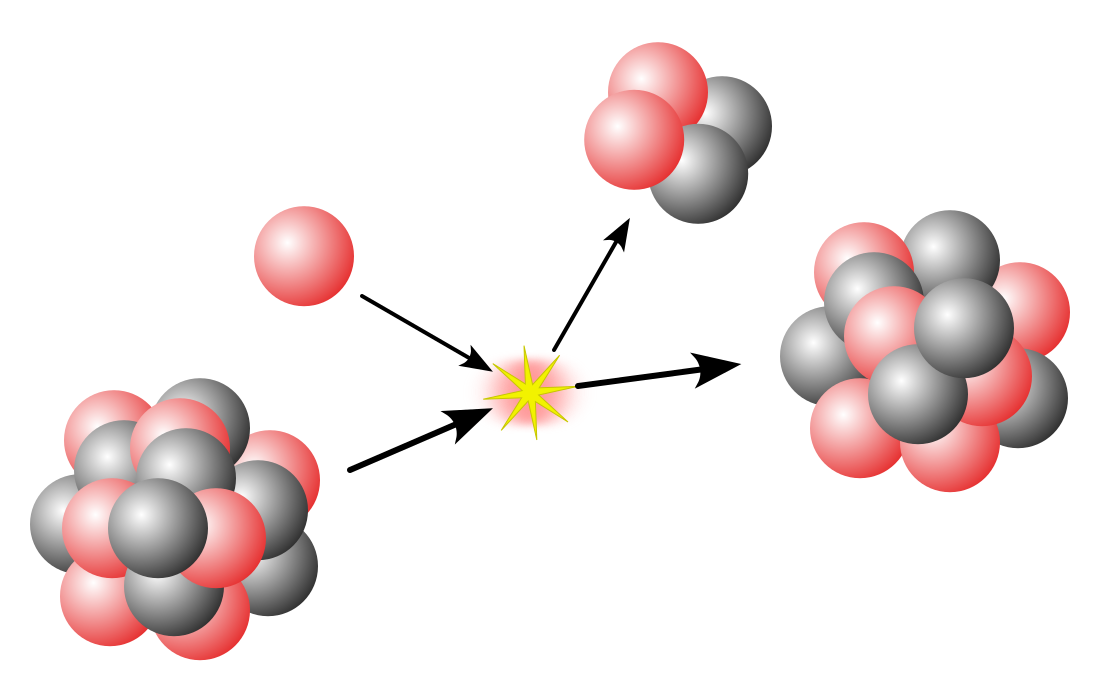Nuclear structure
More information  ,
,  ...
...
| Physical situation |
Nomenclature |
Equations |
| Mass number |
- A = (Relative) atomic mass = Mass number = Sum of protons and neutrons
- N = Number of neutrons
- Z = Atomic number = Number of protons = Number of electrons
|
 |
| Mass in nuclei |
- M'nuc = Mass of nucleus, bound nucleons
- MΣ = Sum of masses for isolated nucleons
- mp = proton rest mass
- mn = neutron rest mass
|
   
|
| Nuclear radius |
r0 ≈ 1.2 fm |

hence (approximately)
- nuclear volume ∝ A
- nuclear surface ∝ A2/3
|
| Nuclear binding energy, empirical curve |
Dimensionless parameters to fit experiment:
- EB = binding energy,
- av = nuclear volume coefficient,
- as = nuclear surface coefficient,
- ac = electrostatic interaction coefficient,
- aa = symmetry/asymmetry extent coefficient for the numbers of neutrons/protons,
|
 where (due to pairing of nuclei)
where (due to pairing of nuclei)
- δ(N, Z) = +1 even N, even Z,
- δ(N, Z) = −1 odd N, odd Z,
- δ(N, Z) = 0 odd A
|
|
Close
Nuclear decay
More information  ,
,  ...
... Close
Nuclear scattering theory
The following apply for the nuclear reaction:
- a + b ↔ R → c
in the centre of mass frame, where a and b are the initial species about to collide, c is the final species, and R is the resonant state.
More information  ,
,  ...
...
| Physical situation |
Nomenclature |
Equations |
| Breit-Wigner formula |
- E0 = Resonant energy
- Γ, Γab, Γc are widths of R, a + b, c respectively
- k = incoming wavenumber
- s = spin angular momenta of a and b
- J = total angular momentum of R
|
Cross-section:

Spin factor:

Total width:

Resonance lifetime:

|
| Born scattering |
- r = radial distance
- μ = Scattering angle
- A = 2 (spin-0), −1 (spin-half particles)
- Δk = change in wavevector due to scattering
- V = total interaction potential
- V = total interaction potential
|
Differential cross-section:

|
| Mott scattering |
- χ = reduced mass of a and b
- v = incoming velocity
|
Differential cross-section (for identical particles in a coulomb potential, in centre of mass frame):
![{\displaystyle {\frac {d\sigma }{d\Omega }}=\left({\frac {\alpha }{4E}}\right)\left[\csc ^{4}{\frac {\chi }{2}}+\sec ^{4}{\frac {\chi }{2}}+{\frac {A\cos \left({\frac {\alpha }{\hbar \nu }}\ln \tan ^{2}{\frac {\chi }{2}}\right)}{\sin ^{2}{\frac {\chi }{2}}\cos {\frac {\chi }{2}}}}\right]^{2}}](//wikimedia.org/api/rest_v1/media/math/render/svg/0039aaab8e6cc5e9699a9193cf602022b7ddb472)
Scattering potential energy (α = constant):

|
| Rutherford scattering |
|
Differential cross-section (non-identical particles in a coulomb potential):

|
|
Close
Fundamental forces
These equations need to be refined such that the notation is defined as has been done for the previous sets of equations.
More information  ,
,  ...
...
| Name |
Equations |
| Strong force |
 |
| Electroweak interaction |

   
|
| Quantum electrodynamics |
 |
Close

 ,
,  ...
...







 ,
,  ...
...




 ,
,  ...
...


 ,
,  ...
...


![{\displaystyle {\frac {d\sigma }{d\Omega }}=\left({\frac {\alpha }{4E}}\right)\left[\csc ^{4}{\frac {\chi }{2}}+\sec ^{4}{\frac {\chi }{2}}+{\frac {A\cos \left({\frac {\alpha }{\hbar \nu }}\ln \tan ^{2}{\frac {\chi }{2}}\right)}{\sin ^{2}{\frac {\chi }{2}}\cos {\frac {\chi }{2}}}}\right]^{2}}](http://wikimedia.org/api/rest_v1/media/math/render/svg/0039aaab8e6cc5e9699a9193cf602022b7ddb472)


 ,
,  ...
...



